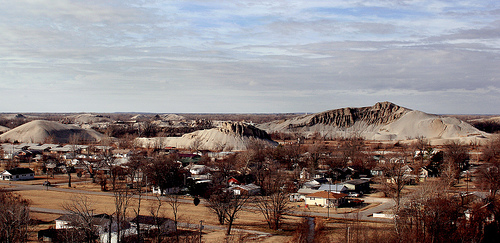 [Image: Empty homes in Picher, Oklahoma; photo by BLDGBLOG].
[Image: Empty homes in Picher, Oklahoma; photo by BLDGBLOG].
On the way west, I managed to stop by the town of Picher, Oklahoma, the subject of a new exhibition featuring photographs by Todd Stewart.
Picher is something like the Centralia of Oklahoma, where Centralia is the town in Pennsylvania that has been slowly abandoned over a generation due to coal mine fires burning away beneath its streets. In Picher, however, it’s not coal smoke but collapsing lead mines that have led to a forced buy-out and evacuation, a haunting process tragically assisted in 2008 when a massive tornado hit town, ripping apart many of its remaining houses and buildings.
Today, Picher is not entirely empty, but it has become more of a macabre curiosity on the state’s border with Kansas, its quiet streets overgrown and surrounded by looming piles of “chat,” or mine tailings, alpine forms that give the landscape its toxic profile.
 [Image: Picher, surrounded by its toxic artificial landforms; via Google Maps].
[Image: Picher, surrounded by its toxic artificial landforms; via Google Maps].
The Washington Post visited the town back in 2007. “Signs of Picher’s impending death are everywhere,” they wrote at the time. “Many stores along Highway 69, the town’s main street, are empty, their windows coated with a layer of grime, virtually concealing the abandoned merchandise still on display. Trucks traveling along the highway are diverted around Picher for fear that the hollowed-out mines under the town would cause the streets to collapse under the weight of big rigs.” Note that this was written a year before the tornado.
Oklahoma native Allison Meier has written up Todd Stewart’s exhibition, including a longer, horrific backstory to the town, with red rivers of acidic water “belching” up from abandoned mines, kids playing in sandboxes of powdered lead, and horses poisoned by the runoff.
“The poisoning of Picher may seem like a local story,” Meier writes, “and, indeed, remains little known on a national level. Yet the state of Oklahoma continues to practice environmentally hazardous extraction, including fracking for gas. And in the United States, the promotion of toxic industry—even if it results in the destruction of the very place it is supporting—endures.”
Here’s a link to the actual exhibition, and you can buy a copy of Todd Stewart’s book here. Wired also visited Picher a few years back, if you’re looking for more.
 [Image: “Chat piles” looming round the “abandoned storefronts and empty lots” of Picher, OK; photo by
[Image: “Chat piles” looming round the “abandoned storefronts and empty lots” of Picher, OK; photo by